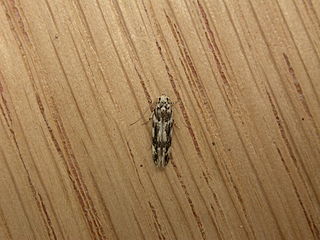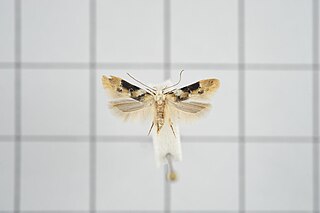
The purple sandpiper is a small shorebird in the sandpiper family Scolopacidae. This is a hardy sandpiper that breeds in the arctic and subarctic regions of Eurasia and North America and winters further south on the Atlantic coast.

Ruppia, also known as the widgeonweeds, ditch grasses or widgeon grass, is the only extant genus in the family Ruppiaceae, with eight known species. These are aquatic plants widespread over much of the world. The genus name honours Heinrich Bernhard Rupp, a German botanist (1688-1719). They are widespread outside of frigid zones and the tropics.

Parachronistis is a genus of moths in the family Gelechiidae.

The shoulder-striped clover is a species of moth of the family Noctuidae. It is found in most of Europe, Ukraine, southern Russia and southern Siberia, Transbaikalia, Turkey, central Asia, China, Japan, the Korean Peninsula, Mongolia, northern India, Pakistan, the Russian Far East.

Ruppia maritima is an aquatic plant species commonly known as beaked tasselweed, beaked ditchgrass, ditch grass, tassel pondweed and widgeon grass. Despite its scientific name, it is not a marine plant; is perhaps best described as a salt-tolerant freshwater species. The generic name Ruppia was dedicated by Linnaeus to the German botanist Heinrich Bernhard Ruppius (1689–1719) and the specific name (maritima) translates to "of the sea".

Parachronistis albiceps, the wood groundling, is a moth of the family Gelechiidae. It is found in most of Europe, except the Iberian Peninsula and part of the Balkan Peninsula. Outside of Europe, it is found in southern Siberia, the Russian Far East and Korea.
Parachronistis fumea is a moth of the family Gelechiidae. It is found in Japan and Russia.
Parachronistis geniculella is a moth of the family Gelechiidae. It is found in Korea.
Parachronistis sellaris is a moth of the family Gelechiidae. It is found in Korea and the Russian Far East.
Parachronistis jiriensis is a moth of the family Gelechiidae. It is found in Korea and the Russian Far East.
Parachronistis destillans is a moth of the family Gelechiidae. It is found in India (Assam).
Parastenolechia suriensis is a moth of the family Gelechiidae. It is found in southern and central Korea.

Parastenolechia asymmetrica is a moth of the family Gelechiidae. It is found in Taiwan and Korea.
Parastenolechia albicapitella is a moth of the family Gelechiidae. It is found in Korea.
Parastenolechia argobathra is a moth of the family Gelechiidae. It is found in Korea, Japan, the Russian Far East and China.
Parastenolechia claustrifera is a moth of the family Gelechiidae. It is found in China (Zhejiang) and Taiwan.
Parastenolechia issikiella is a moth of the family Gelechiidae. It is found in Japan and Korea.
Parastenolechia superba is a moth of the family Gelechiidae. It is found in Korea and the Russian Far East.
Parastenolechia collucata is a moth of the family Gelechiidae. It is found in Korea and the Russian Far East.

Parastenolechia nigrinotella is a moth of the family Gelechiidae. It is found in Turkey, on Sicily and in Spain, France, Italy, Austria, the Czech Republic, Slovakia, Croatia, Hungary, Romania, Bulgaria, North Macedonia and Greece.






